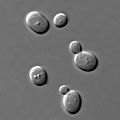Asexual reproduction facts for kids
Asexual reproduction is a way for living things to make new copies of themselves without needing a partner. It's like making a perfect copy!
In this process, one parent organism or even a single cell creates a new individual. The new copy is almost exactly the same as the parent. It has the same genes, which are like the instruction manual for the body. These copies are called clones. Sometimes, tiny changes called mutations can happen, but they are rare.
Contents
How Asexual Reproduction Works
The main way asexual reproduction happens is through a process called mitosis. This is when a cell divides into two identical new cells. Think of it as one cell splitting to become two.
Single-Celled Organisms
Asexual reproduction is very common in tiny, single-celled living things.
- For example, an Amoeba is a tiny organism that simply splits itself in half to make two new amoebas. Each new amoeba is a clone of the first one.
Plants and Their Life Cycles
Many plants also reproduce without seeds or pollen from another plant.
- Some plants, like strawberries, use special stems called runners. These runners grow along the ground and can sprout new plants.
- The "mother-of-thousands" plant (Bryophyllum daigremontianum) grows tiny plantlets right on the edges of its leaves. These little plants drop off and can grow into new plants.
Animals and Their Reproduction
Asexual reproduction happens in many different animals too.
- Corals and bryozoans are animals that live in colonies. Each individual in the colony is usually a clone. They are made by the first animal dividing over and over.
- Some types of rotifers (tiny animals found in water) called bdelloid rotifers have only asexual reproduction. They don't need a partner to have babies.
- Aphids are small insects that can give birth to live young without a male aphid. The babies are clones of the mother.
- All the daughters of a honey bee queen develop from eggs that were not fertilized by a male bee. This is also a form of asexual reproduction.
- Some starfish, like Linckia guildingi, can regrow a whole new body from just one arm. If an arm breaks off, it can sometimes grow into a new starfish.
- Even some lizards, like the desert grassland whiptail lizard, can reproduce asexually. The females can lay eggs that hatch into new lizards without needing a male. This is called parthenogenesis.
Double Life Cycles
Many living things have a "double life cycle." This means they can reproduce in two different ways.
- At one time, they might reproduce sexually, needing two parents.
- At another time, they might simply multiply by splitting or by producing eggs that develop without fertilization. This shows how common asexual reproduction is in nature.
Images for kids
-
The yeast Saccharomyces cerevisiae reproducing by budding
-
Linckia guildingi "comet", a starfish regrowing from a single arm
-
Aphid giving birth to live young from an unfertilized egg
See also
 In Spanish: Reproducción asexual para niños
In Spanish: Reproducción asexual para niños








